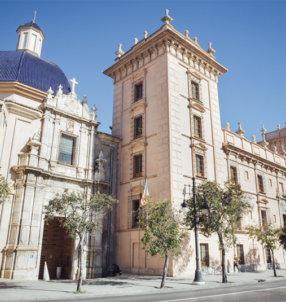Valencian Poet
Nobody seems to agree on where or when Ausiàs March was born. Tradition tells us that it was 1397 in Gandia although some modern historians say it was three years later and in Beniarjó. Others say he was born in the city of Valencia city itself and there are even those who seem to be under strange illusion that he was born in Catalonia. However, the date of his death, March 3, 1459 in his house in C/ Cavillers just off the Plaza de la Reina, is not in dispute and this year Valencians are celebrating the 550th anniversary of his death.
Buried down the road from where he lived, in the Valencia Cathedral (just inside the Puerta del Palau), Ausiàs March’s 128 published poems make him the most prolific writer in medieval Europe. He is as important to the Valencian language as Cervantes is to Spanish or Shakespeare to English.
The favoured son of a comfortable middle class family of intellectuals, March, as was expected of young men of his class, went into the army and took part in Alfonso V’s campaigns against the Barbary pirates and the conquests or Corsica and Sardinia. Like many of his contemporaries, his young life was a chaotic mix of drink, duelling, brawling and womanising. He first became interested in poetry as a way of wooing the ladies. After serving Prince Carlos of Navarre, March left the army in 1429 and joined the court of Don Juan, Duke of Gandia with whom he was embroiled in constant disputes over land rights.
It was in Gandia that he wrote his first known published poems. In the first period his poetry was basically a series of ‘Love Songs’ to his various ‘muses’. March was not a man to make distinctions and he wrote for both single and married women and even nuns. The titles of his collections of poems sound like the canon of some ‘50s rock ’n’ roller – ‘Love, Love’ (Amor, Amor), ‘Oh Crazy Love’ (Oh, Foll Amor), ‘Full Right’ (Plena de Seny) and ‘Lily Amongst Thistles’ (Llir Entre Cards).
His poetry in his period was sensual and direct. It differed from other medieval love poetry in that it treated women as flesh and blood rather than the spiritually romantic ideal of chastity and purity favoured by other poets and artists of the time. He was the first poet to write in the cultured Valencian language of the court rather than the Occitan, which previous Valencian poets had used.
In 1437 March married Isabel Martorell, the sister of ‘Tirant lo Blanc’ author Joanot Martorell. He settled down and became more established in the court. In 1439 March was honoured by Alfonso V and made Lord of Beniarjó, Pardines and Vernissa and bestowed with the title of ‘‘Lord Falconer of the Kingdom of Valencia’’.
Isabel died just two years after they were married, which had a profound effect on March and led to the beginning of a new, more mature period in the poet’s work which is usually referred as the ‘Death Songs’. This was his Jonny Cash period. The direct style remains but the poems are dark and deep with an underlying pessimism. His poems of the joys of young love are replaced with a more thoughtful, sceptical approach to life and in some of the pieces he even seems to blame himself for his wife’s death. Titles like ‘Destiny of the Soul’ (Destino del Alma), ‘Pain of Absence’ (Dolor por la Ausencia) and ‘Memory of Things Past’ (Recuerdo del Pasado) illustrate the poet’s new maturity and darker mood. During this period he married again in 1443 and moved to Valencia.
In the last ten years of his life, until his death in 1559, the ageing March did his most celebrated and most complete work. In this last period, March recovered the freshness of the poetry of his youth and melded it with the maturity of his middle period. In this phase of his work he began to accept his own mortality and largely directed his attention towards God and spirituality. True to his direct style,they included a public confession of his sins in ‘Spiritual Song’ (Canto Espiritual), one of the most important works of poetry of the medieval period.
March’s poems have been translated into 50 languages and original copies of his works can be found in the Valencia Library, the Spanish National Library in Madrid, King’s College Library in London and the French National Library in Paris. His work, widely read at the time, had a huge influence on poets in the 15th and 16th centuries and he has once more come back into the spotlight with the celebration of the 550th anniversary of his death and the official declaration of 2009 as International Ausiàs March year. His enduring popularity was illustrated recently when one of his poems ‘Veles i Vents’ gave its name to the most emblematic building in the America’s Cup development. Sincere and soulful, March was one of the key figures of the Golden Age of the Aragon crown and without doubt a giant of Valencian literature.
David Rhead and José Marín
Related Post
This site uses Akismet to reduce spam. Learn how your comment data is processed.


























Leave a comment